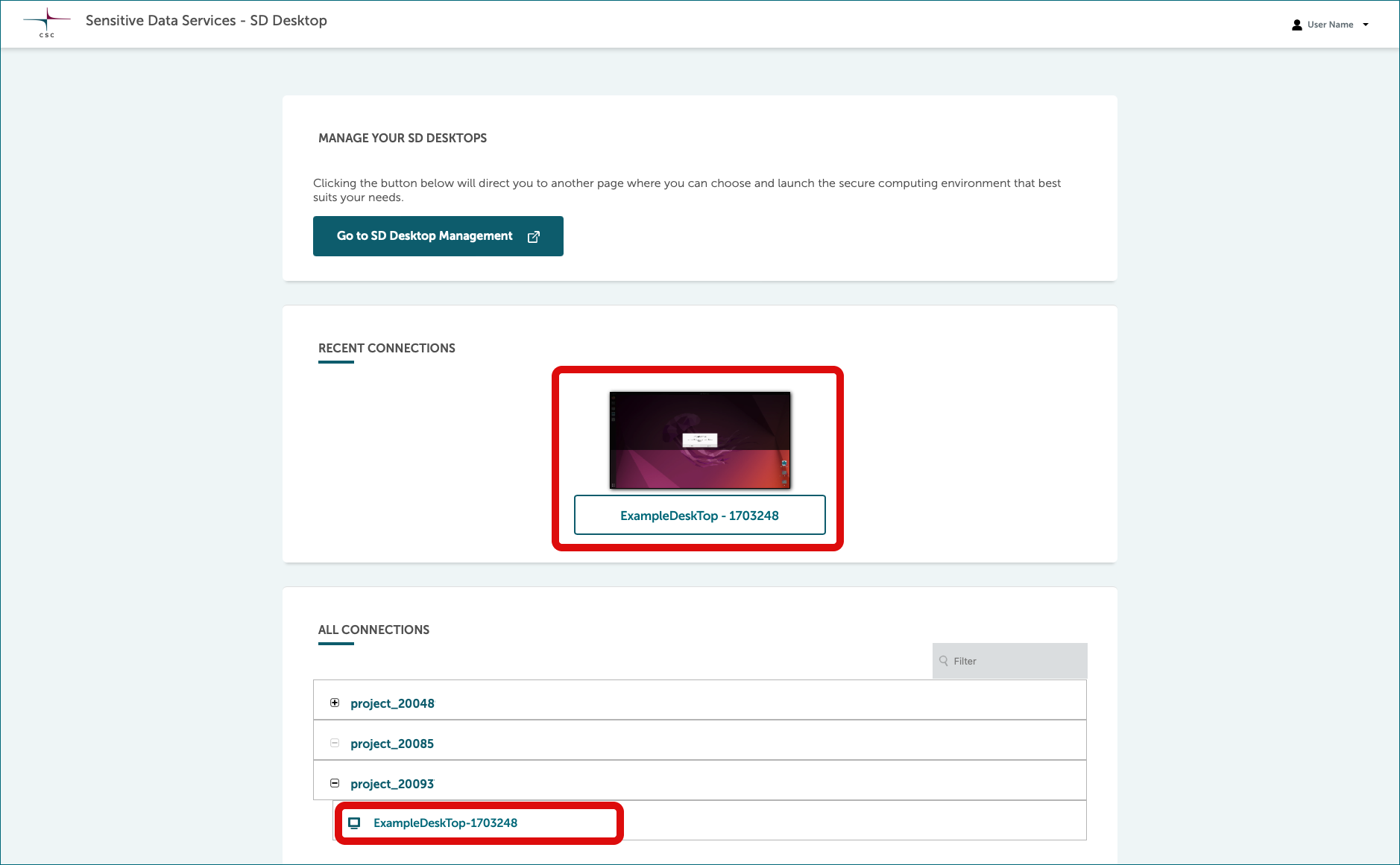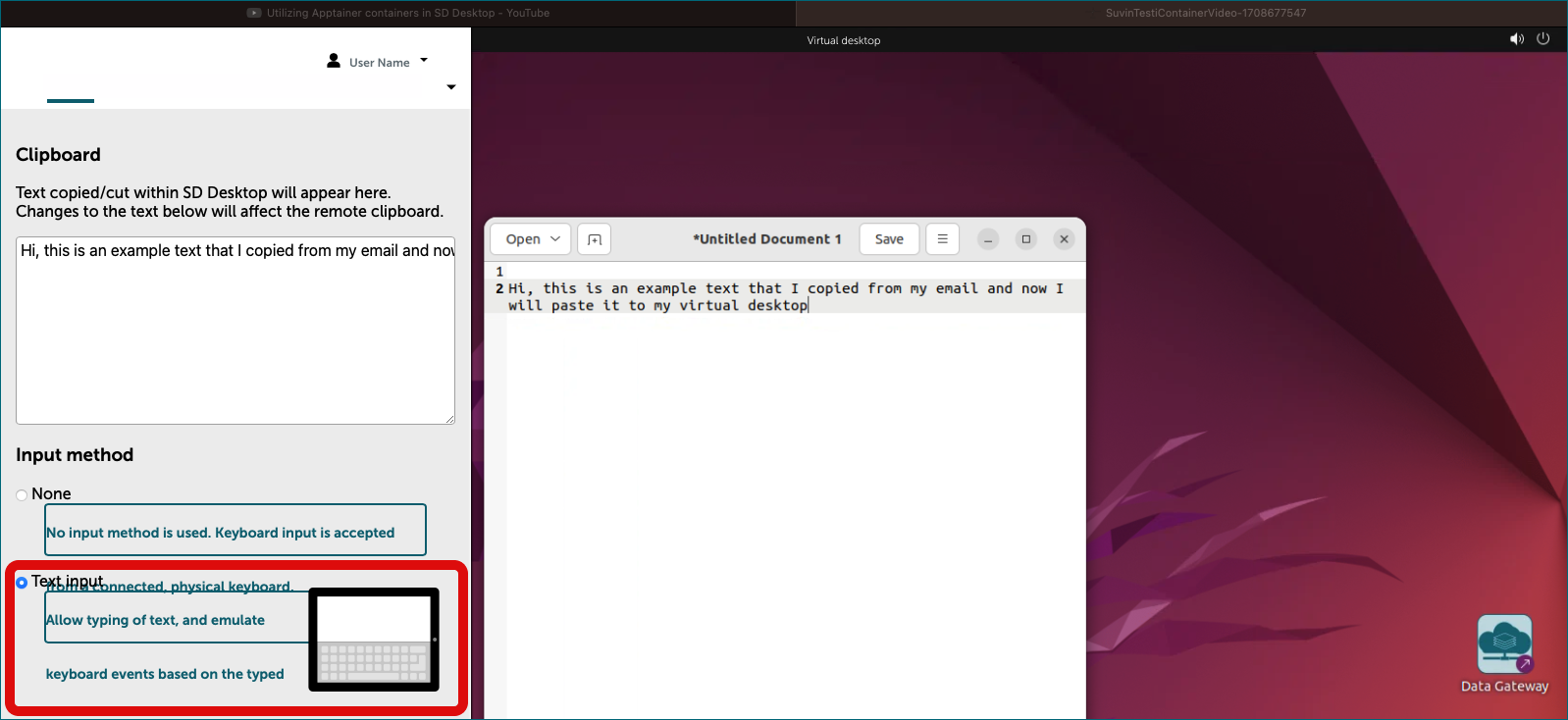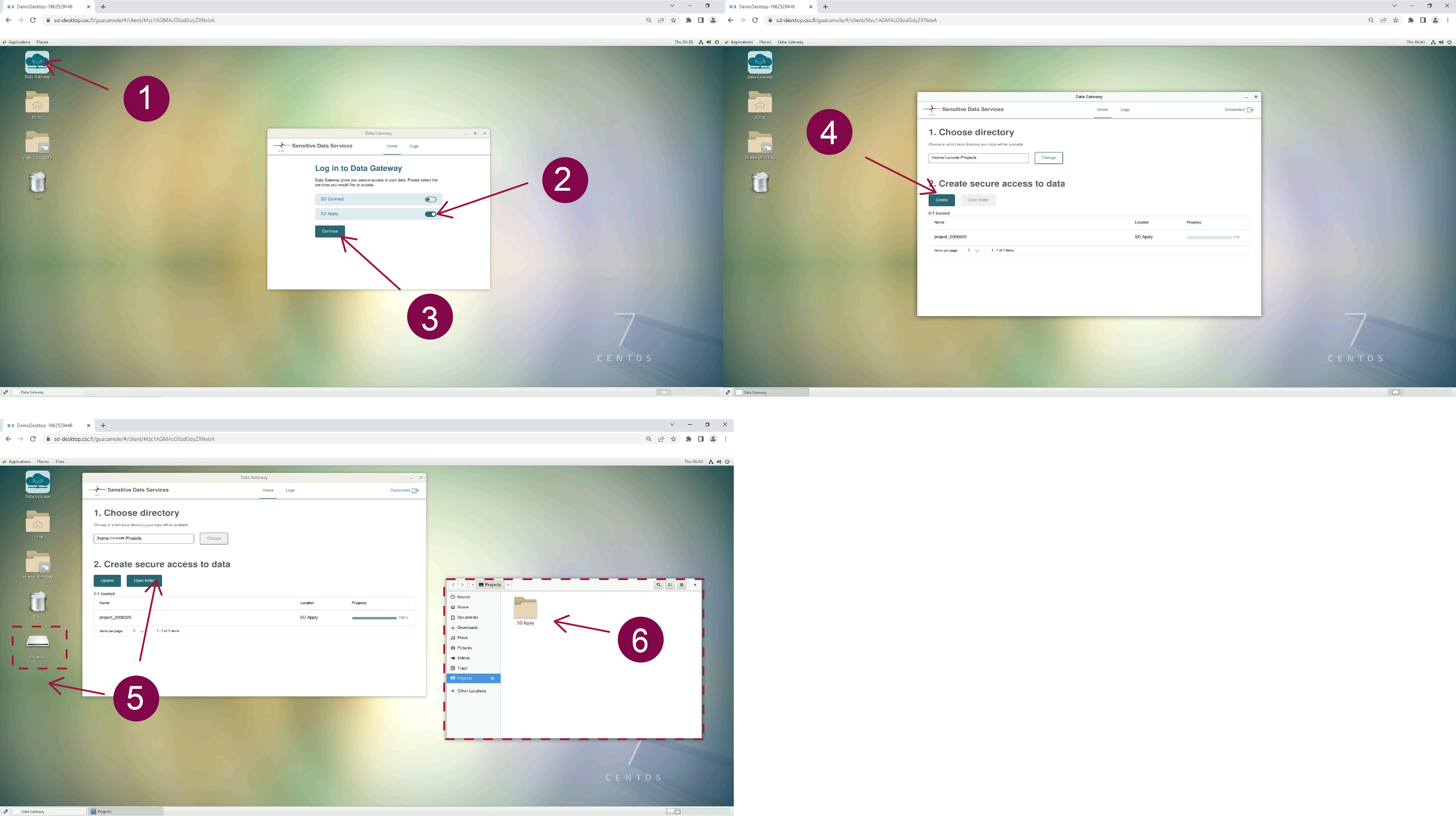Working with your virtual desktop
Once your virtual Desktop is launched, each CSC project member can securely access it from their browser at any time.
Access virtual desktop
After log in, you will see all your virtual desktops listed at the front page, under All connections.
- All connections. Select project (e.g.
project_NNNNN) and click the plus-sign. There you can see all desktops that belongs to this project (desktopname-NNNNNNNNNN). Access virtual desktop by clicking the name. - Recent connections. Your recently used virtual desktops appear also here.

When you open the connection, a virtual computing environment will open in your browser. If you are accessing the virtual desktop for the first time, you will see the panel getting started, from which you can, for example, adjust the screen resolution.
You can work with your virtual desktop like with a standard computer, accessing several pre-installed programs from the applications menu bar (top left corner). Examples include Open Office, image-viewing applications, video and audio players, Jupyter Notebooks etc. You can also open a terminal and use Linux from the command line. For more information on accessing R-Studio, please check the paragraph below.
Security-related features of the audited SD Desktop include:
- The computing environment is isolated from the internet. You can, for example, open a Firefox web browser, but you are not able to access any site on the internet. You will also not be able to access any repositories directly.
- The copy-paste function from your computer/laptop to your virtual desktop is limited for security reasons. Instructions how to copy-paste.
You can close your connection to your virtual Desktop in two ways:
- Log out from your Desktop (in the workspace view, top right corner of the browser, select your username and log out). This will close all applications in your virtual Desktop and disconnect the work session. You will be able to re-access the virtual Desktop at any time by logging in to the services.
- If you started a data analysis programmatically (you are running a script) you can close the browser window. This doesn't interfere with the processes running. Thus, when you reconnect to your Desktop, you have all your tools and interfaces still open and can continue working. However, remember to log out from the Desktop once the analysis is finished. If you leave more than ten connections open, you will be unable to re-access the services.
Note
Never use the lock or reboot buttons in SD Desktop as you will not be able to connect to the Desktop again after that.
Accessing data using Data Gateway
Once you sign in to your virtual Desktop, you can access the data by following these steps:
- Open Data Gateway (you can find the application on your desktop);
- Select SD Apply;
- Click on Continue;
- In the new window, under the second step, click on Create. The application will create a new folder called Projects accessible from your Desktop or programmatically through the terminal.
- Click on Open folder.
- The files have been encrypted using the sensitive data public encryption key, and you will be able to access their content in read-only mode. The current streaming speed can be up to 50 MB/s.
Note
The Projects folder is available only when the Data Gateway application is open. If you close or disconnect the application, you will not be able to access the data stored in the data service unless you previously made a full copy of it inside your Desktop. Thus, Data Gateway needs to be open and connected during data processing.
If you need to edit files/data
- Access the files of interest in the Project-folder using Data Gateway;
- Select all the necessary files from the Project-folder, make a copy and save it in the virtual Desktop's home directory (the files will be visible only from your browser) or in the shared folder (in this case, the files will be accessible also by the other CSC project members).
Copy-paste from your laptop to virtual desktop
The copy-paste function from your computer/laptop to your virtual desktop is limited for security reasons. However it is possible to copy-paste text with Clipboard:
- Copy text normally from your computer (Cntrl+C).
- Go to virtual desktop and open a Clipboard with a key combination Cntrl+Alt+Shift.
- Paste your text to the Clipboard.
- Copy the text again from the Clipboard. Please note that the Cntrl+C won't work here, use the mouse right-click instead.
- Now you can paste the text inside your virtual desktop.
- When you are ready, close the Clipboard with Cntrl+Alt+Shift.

Default programs available on the Desktop and software customisation
Each virtual Desktop is pre-built and contains a limited set of default open-source software (listed below). The virtual Desktop is isolated from the internet and importing of software is restricted, as required by the data permit authority. Thus, users cannot directly import software/scripts or other files on to their virtual Desktop when working with secondary use data.
If you need a specific program that is not pre-installed, it is recommended to contact CSC Service Desk before applying for the data permit. This way, we can figure out if it is possible to customise your virtual desktop.
Pre-installed software:
- CentOS7 (Operating system)
- Emacs (Text editor)
- htLib (A library)
- LibreOffice (An open-source alternative to Microsoft Office)
- miniconda (Installer for conda, a bootstrap version of Anaconda)
- minimap2 (A sequence alignment program)
- pigz (A compression tool for files)
- pyro.ai (A tool for deep probabilistic modeling)
- Python
- R + R studio
- SAMtools (Programs for interacting with high-throughput sequencing data)
- nextflow (A workflow orchestrator)
- Go (Programming language)
Scientific software
Python 3.7.9 including following packages:
- Beautiful Soup, Bokeh, CatBoost, crypt4gh, Distributed Keras, Elephas, ELI5, Gensim, HTTPX, Keras, LightGBM, Matplotlib, NLTK, NumPy, pandas, Plotly, pydot, pyfuse3, PyTorch, QRcode, Scikit-learn, SciPy, Scrapy, Seaborn, spaCy, Statsmodels, TensorFlow, Trio, XGBoost.
R / RStudio Server with the following properties:
- Installation matching the
r-env-singularity/4.0.5module on Puhti (R 4.0.5 + RStudio Server 1.4.1106, Bioconductor 3.12) - 1000+ pre-installed R packages
- Intel® oneAPI Math Kernel Library (oneMKL)
- GIS software (PROJ, GDAL, SAGA)
- CUDA drivers
- TensorFlow (used with R TensorFlow back-end)
- R + RStudio Server versions matched with Puhti r-env-singularity module (R 4.0.5 + RStudio Server 1.4.1106, MRAN, Bioconductor 3.12)
RStudio on SD Desktop
To access RStudio on SD Desktop, open the terminal from the Applications tab in your virtual Desktop and launch RStudio with:
start-rstudio-server
This will return a URL and a service-specific password:
RStudio Server - Sensitive Data Desktop Edition
---------------------------------------------------------------------------------------
Copy/Paste this URL into Firefox:
http://localhost:8787/
-----------------------------------------------------------------------------------------
Enter these at the RStudio Server sign-in screen
----------------------------------------------------------------------------------------
Username: accountname Password: Example23241232
----------------------------------------------------------------------------------------
To stop RStudio Server: Ctrl+C
Next:
- paste the URL in Firefox
- after a few seconds, you can input the username and password (given by the terminal) and access the server.
Note
When using RStudio, you need to save your data in shared-directory if your colleagues need to access the same files.
Limitations to SD Desktop
To comply with the regulation, SD Desktop for secondary use is completely isolated from the internet and other services. You can, for example, open a Firefox web browser, but you are not able to access any site on the internet.
The import of data and software is restricted in SD Desktop. You cannot import any data or software yourself for security reasons. If you are working with a dataset for which you have received a permit from a data controller, the only way to access the data for analysis is by utilizing a specific application called Data Gateway.
Data export from SD Desktop is also restricted. Only non-sensitive results can be exported from the workspace, and those can only be exported by the CSC project manager. Instructions for exporting your results are provided in the next paragraph.
Encrypted files will be visible in read-only mode. This solution allows you to process large amounts of data without storing any copy on your virtual Desktop. However, this means that the files cannot be edited in SD Desktop.
Lastly, we are not yet providing a virtual Desktop with Windows operating system, or with GPUs. However, we are working on it, and you can find more information on the future developments of the services on our webpage.



